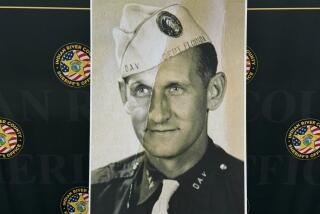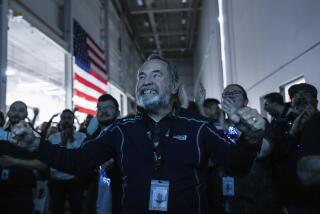Lee Davenport dies at 95; physicist developed WWII radar device
Lee Davenport, a physicist who developed a radar device that helped U.S. and Allied troops win key battles in World War II, has died. He was 95.
He died Friday of cancer at a nursing home in Greenwich, Conn., said his daughter, Carol.
Davenport was among hundreds of scientists who worked at the secret MIT Radiation Laboratory, even before the United States joined the war in 1941, to develop radar systems that would give the American military an edge. He was credited with developing the SCR-584 — the letters standing for Signal Corps Radio — a microwave radar built into a semitrailer with a parabola on top that tracked enemy planes and helped to direct antiaircraft batteries.
The radar helped to counter the German air force and aided troops who shot down planes during German air attacks on Italy’s Anzio beachhead in 1944.
Davenport went to England to waterproof radar semitrailers that were to be floated ashore at Normandy in the D-Day invasion on June 6, 1944. After the landing, he was sent to France to continue developing applications for the radar.
“They issued papers for me to be known as a captain in the Signal Corps,” Davenport said in a 2010 interview with the Greenwich Citizen, a weekly newspaper. “I had all the dog tags and identification. When you are a civilian and are overseas in a war zone, that civilian would need protection, for if he was caught by the enemy for any reason he would be shot as a spy.”
A targeting system developed for the SCR-584 later helped Allied pilots target enemy vehicles in snowy conditions at the Battle of the Bulge in Europe.
Carol Davenport recalled simpler technological lessons from her father, an avid collector of antique cars.
“He was insistent that my sister and I learn to change a tire,” she said.
Davenport was born Dec. 31, 1915, in Schenectady, N.Y., where his father was a schoolteacher. He graduated from Union College in Schenectady in 1937 and earned a doctorate in physics from the University of Pittsburgh based on the work he did at the MIT Radiation Lab. He also taught at MIT and Harvard, where he was responsible for the nuclear lab.
Davenport later had a 24-year career with GTE Corp. and various subsidiaries, retiring as vice president and chief scientist.
In a 1991 oral history interview with the IEEE, a professional association formerly known as the Institute of Electrical and Electronics Engineers, Davenport said he developed an early interest in science and was an avid reader of Popular Mechanics magazine. At a young age, he said, he made small electric motors from paper clips, copper wire and low-voltage batteries.
Davenport credited a college physics professor with giving him his start in science.
In 1934, he was removing insects from plants for 35 cents an hour when Peter Wold, chairman of the physics department, invited him to help make scientific drawings, he told a Union College interviewer.
“It’s better than picking bugs off salvias,” he said.
More to Read
Start your day right
Sign up for Essential California for the L.A. Times biggest news, features and recommendations in your inbox six days a week.
You may occasionally receive promotional content from the Los Angeles Times.




















































